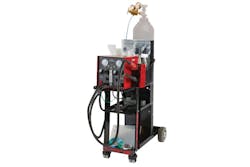HOW IT WORKS:
Garrick Fulbright says he was skeptical when he first learned of nitrogen plastic welding.
“The first I ever heard of one was in a magazine and I went, ‘Yeah, right,’” he says. “I thought, ‘If one of those ever worked, it would be great.”
However, as the dealer shop Fulbright manages, Dick’s Collision Center in Portland, started seeing more and more plastic repair, he started wondering if a plastic welding system might be worth the investment.
“Plastic is one of those things,” he says. “The shop either has the idea that they can fix it because they have a repair mentality or they get forced into fixing one by an insurance company and have to replace. The reality is, you need to be able to do both. If you don’t have the ability to repair plastic and someone else does, you’re already losing. That’s how I looked at it.”
Although the technicians were skeptical when the shop’s jobber brought in the Nitro Fuzer Nitrogen Plastic Welding System for a demo, Fulbright says it was a “night-and-day” reaction after the demonstration.
The nitrogen gas system combines hot air and nitrogen welding capabilities to create a strong weld that eliminates oxidation of the plastic during the welding process. The system comes with the welder, regulator, hand seamer, welding cart, aluminum tape, stainless steel tip cleaning brush, and an assortment of welding rods, tips and ceramic airless welding elements.
“By the time the demo was over, [the techs]both said they wanted it,” he says. “After you see what it can do and you had a preconceived notion that it’s going to fail, that’s a huge eye-opener.”
Fulbright says the system has “saved him” in the shop.
“We have repaired headlights, plastic tabs, bumper covers, grills. You name it, if it’s plastic, we can repair it,” he says. “I have experienced where a technician is putting a car together and someone missed one of the tabs on a front cover that was cracked or snapped, and all of a sudden, it’s not holding correctly. Being able to do that and having to paint the front part of the cover is huge. It saves you from that.”
THE RETURN:
Fulbright says that besides the time savings and decrease in redos, it took his shop two months to recoup the cost.
“After I took into account the cost of the plastic rod, the nitrogen, the electricity, the tech time and the learning curve, I calculated I was going to have to bill out 75 hours to recoup the cost,” he says.
He even goes so far as to say that if the system took two years to recoup costs, he considers it worth having.
“We repair a lot of plastic,” he says. “At this point, we repair way more plastic than we replace.”



